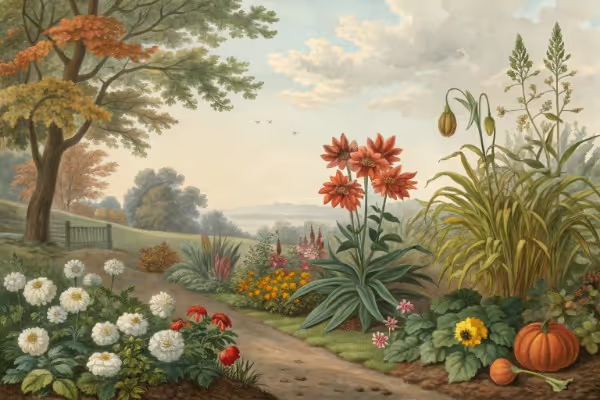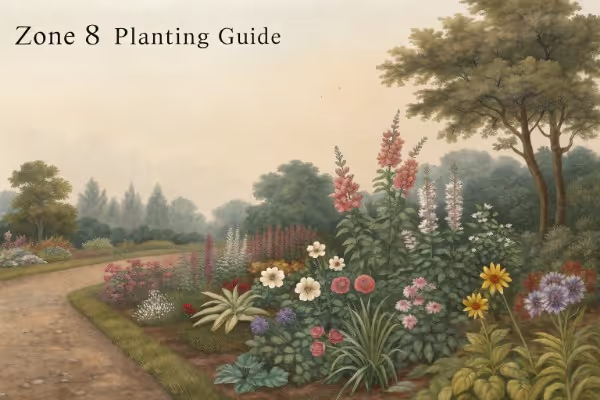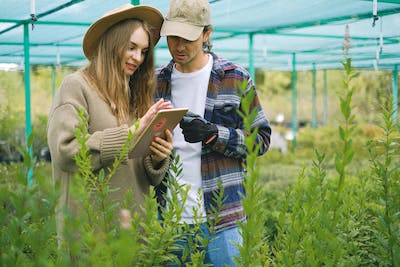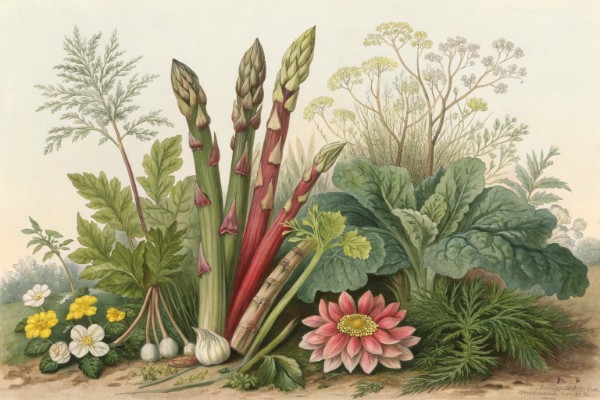Gardening Quiz: How Well Do You Really Know Your Garden?
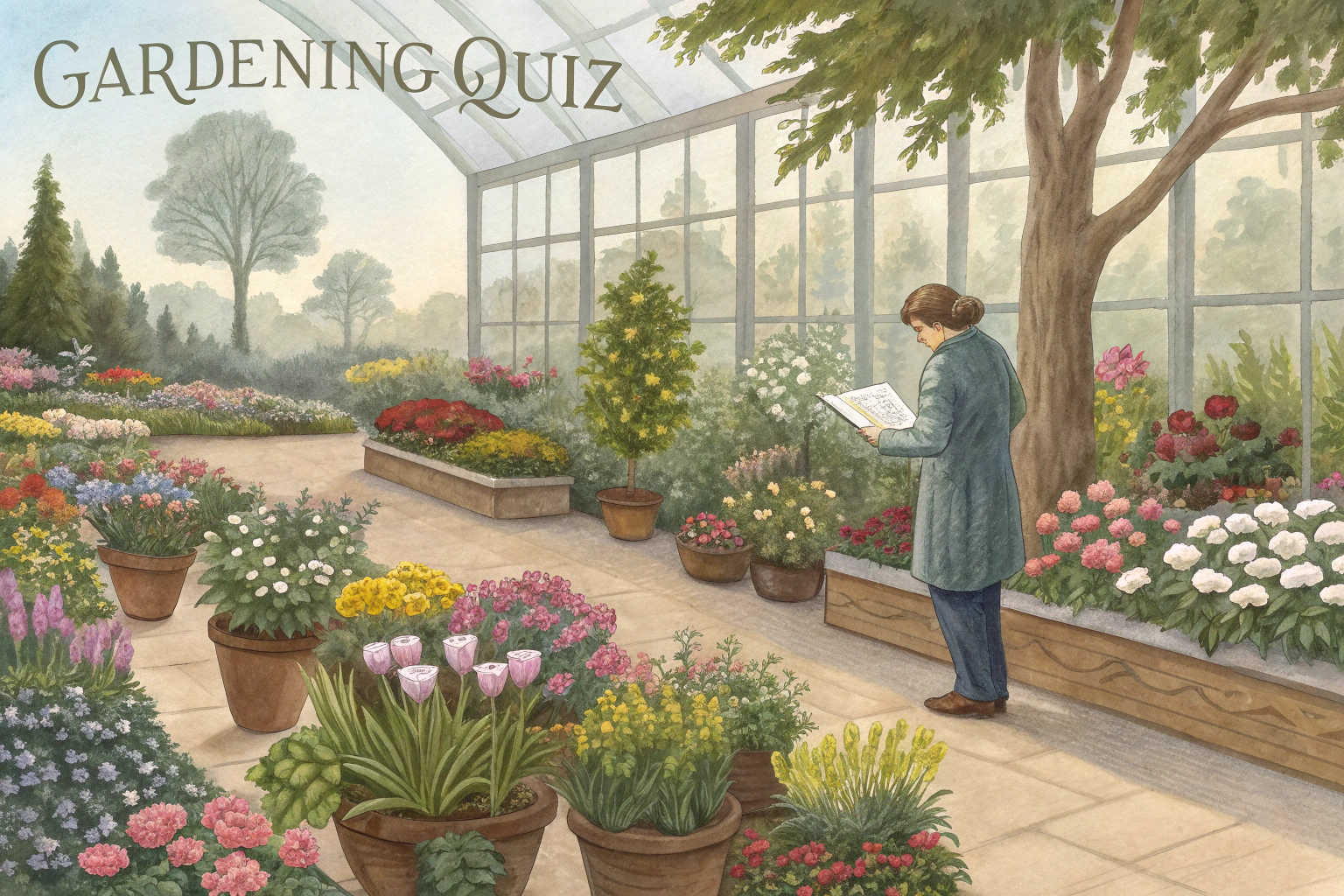
Gardening quiz
Want to sharpen your plant know-how? This gardening quiz will challenge your practical skills and botany knowledge with questions rooted in real horticultural science. Use this gardening quiz to gauge your grasp of techniques, plant care, and seasonal timing—backed by centuries of practice.
Ready to dig in and see how you stack up? Let’s see what you really know.
Cheatsheet: Ace Every Gardening Challenge
🌱 Know Your Zones
USDA/UK Hardiness zones direct plant choices. Zone 3: -40°F/-40°C. Zone 10: 40°F/4°C minimum. Match plants to zones for survival.
🕰️ Planting Timelines
- Spring: Sow hardy annuals, prep soil
- Summer: Water deeply, mulch beds
- Fall: Plant bulbs, divide perennials
- Winter: Prune, plan, order seeds
🥗 Grow for Nutrition
Leafy greens: Harvest in 30 days. Tomatoes: Rich in lycopene, mature in 75 days. Carrots: Vitamin A, ready in 60 days.
🌾 Soil & Compost
Test soil pH: 6-7 ideal. Amend with compost for yields up to 30% higher. Rotate crops every year.
💧 Water Wisely
- Early morning: Best time
- 1 inch/2.5cm per week
- Mulch reduces evaporation
🦋 Biodiversity Benefits
Pollinator-friendly gardens increase fruit set by 24%. Mix natives, herbs, and flowers.
🛠️ Tools and Products You'll Need
- Trowel
- Pruners
- Soil tester
- Compost
- Mulch
- Quality seeds or seedlings
- Drip irrigation (optional)
- pH meter
📝 Quick Steps To Success
- Analyze your zone and yard sun exposure
- Test soil and amend with compost
- Choose plants matched to zone and season
- Sow or transplant, spacing correctly
- Mulch and water consistently
- Monitor pests and diseases weekly
- Harvest at peak ripeness
Gardening Quiz: How Well Do You Really Know Your Garden?
I built this Gardening quiz after too many seasons where my confidence beat my data. My tomatoes taught me humility and my soil test wrote the punchline.
Grab a pencil, a mug of something strong, and let’s see what the garden reveals. The only rule, be honest.
Round 1: Your Site, Your Microclimate
Do you know your first and last frost dates from the nearest 30 year climate normal. NOAA and national meteorological services publish them, and local extension bulletins translate them to planting windows.
My north fence keeps frost three days longer than the rest of the yard, which sets my bean sowing date. Microclimates decide harvests more than seed catalogs do.
“Microclimates can vary by several degrees across a single property.” Source: University Extension climate notes
Round 2: Soil IQ
What is your soil’s pH, texture class, and CEC capacity to hold nutrients. If you paused, order a lab test before your next fertilizer purchase.
Sand drains, silt balances, clay stores, loam forgives. Roots tell the truth by the inch.
“Many mineral soils contain 1 to 6 percent organic matter.” Source: USDA NRCS Soil Health
Aim for 4 to 6 percent organic matter in veg beds, with steady compost rather than boom and bust. I test every other autumn, then adjust in winter when the shovels rest.
Round 3: Water Wisdom
Most gardeners irrigate by hope. Plants drink by physics, through evapotranspiration, and they crave deep, even moisture.
“Vegetable gardens typically need about 1 to 1.5 inches of water per week from rain or irrigation.” Source: University of Minnesota Extension
Use a rain gauge, then finish the gap with drip at 0.5 to 1 gallon per hour emitters, slow and steady. I set my timer to run pre dawn, then check soil 6 inches down with a trowel, not a guess.
Round 4: Light and DLI
Sun maps beat hunches. Track hours of direct light in June and again in March, then plan crops to match.
Daily Light Integral is the total light dose that drives photosynthesis. Fruiting crops like tomato thrive around 20 to 30 mol m-2 d-1, and leafy greens grow well with less. Source: Michigan State University floriculture notes
“Tomato productivity increases with DLI up to roughly 30 mol m-2 d-1.” Source: MSU Runkle lab guidance
Round 5: Pests, Allies, and IPM
Integrated Pest Management starts with scouting and thresholds, then moves to controls in order of least risk. Sprays live at the end of the line, not the front.
“More than 90 percent of insects are beneficial or innocuous.” Source: University of Kentucky Entomology
I carry a 10x hand lens and yellow sticky cards, then snap photos weekly. Beneficials arrive if you give them nectar, water, and patience.
Round 6: Timing by Temperature
Calendar dates lie, soil thermometers do not. Corn waits for 60 to 65 F soil, 15.5 to 18 C, while peas smile at 45 F, 7 C.
Growing Degree Days track heat accumulation and predict events like codling moth flights and tomato ripening. I use base 50 F, 10 C, for warm season crops and record it with my notes.
Round 7: Nutrition Without Guesswork
Plants speak in symptoms, but tests translate fluently. Nitrogen travels in the plant, so older leaves pale first, while iron deficiency chlorosis starts at the newest growth.
Know your NPK analysis and your goal. I spoon feed nitrogen to heavy feeders by split applications, then back off as fruit sets to curb watery growth.
Round 8: Compost Confidence
Great compost smells like forest after rain. Hit a carbon to nitrogen ratio near 30 to 1 and keep piles moist to the feel of a wrung sponge.
“Maintain 135 to 160 F, 57 to 71 C, for several days to reduce pathogens.” Source: EPA composting guidance
I track with a compost thermometer and turn when the core cools. Worms finish what heat begins.
Your 20 Question Gardening quiz
- What is your average last spring frost date within 10 days, and how does your yard differ from it.
- Name your soil texture and the depth of your topsoil layer in inches and centimeters.
- What is your soil pH to the nearest 0.2, and which nutrients become less available outside 6.0 to 7.0.
- Define CEC in one sentence and explain why sandy soils often need lighter, more frequent feeding.
- How many inches of water did your garden receive in the past 7 days, from rain plus irrigation.
- At 90 F, 32 C, what time of day reduces evaporation and leaf scorch during irrigation.
- How many hours of direct sun reach your tomato bed on the summer solstice and in early April.
- What is the approximate DLI target for fruiting vegetables and for salad greens.
- Name three beneficial insects you have actually seen this season and what they eat.
- What is an economic threshold, and how does it guide your IPM decisions.
- Soil temperature for sowing beans and corn, in F and C.
- Base temperature used for warm season GDD calculations and one way you use it.
- Two mobile nutrients and two immobile nutrients, with one symptom for each deficiency.
- Ideal compost C:N ratio, target moisture, and safe internal temperature range in F and C.
- Mulch depth range for perennials and for vegetables, in inches and centimeters.
- pH preference of blueberries and of most brassicas, with a safe acidifying amendment.
- One sign of overwatering and one sign of underwatering that cannot be faked by heat stress.
- Pruning timing for raspberries vs. apples and the reason for the difference.
- Seed viability rule of thumb for onions vs. tomatoes, stored cool and dry.
- A practice you will stop this season, based on data from this quiz.
Answers and Mini Lessons
- Frost dates come from 30 year normals, then microclimates shift them. Low spots frost early, south walls run warmer by 2 to 5 F, 1 to 3 C.
- Texture shapes drainage and aeration. Deep topsoil, 8 to 12 inches, 20 to 30 cm, cushions roots from heat and drought.
- Below pH 6.0, phosphorus and molybdenum lock up. Above 7.5, iron and manganese become less available.
- CEC measures how many nutrient cations soil can hold. Sand has low CEC, so nutrients leach faster.
- Use a rain gauge. One inch per week, 25 mm, is a baseline, then adjust for heat, wind, and soil.
- Pre dawn watering limits evaporation and foliar disease spread. Late evening can leave foliage wet overnight.
- Tomatoes want 8 plus summer hours, early spring far less. Move fruiting crops to the brightest ground.
- Fruiting veg, roughly 20 to 30 mol m-2 d-1. Salad greens, near 12 to 17 mol m-2 d-1.
- Lacewings eat aphids, lady beetles eat mites and aphids, syrphid fly larvae eat soft-bodied pests. Scout for them before you spray.
- The pest level where damage costs more than control. Act only when you cross it, and favor non chemical tactics first.
- Beans and corn at 60 to 65 F soil, 15.5 to 18 C. Cold soil rots seed and stunts emergence.
- Base 50 F, 10 C, for warm season. I schedule sowing, pest models, and harvest targets with GDD totals.
- Mobile, nitrogen and potassium, older leaves show symptoms first. Immobile, calcium and iron, new growth shows symptoms first.
- C:N near 30 to 1, moist like a wrung sponge, 135 to 160 F, 57 to 71 C, for active hot composting.
- Perennials, 2 to 3 inches, 5 to 8 cm. Vegetables, 1 to 2 inches, 2.5 to 5 cm, kept off stems.
- Blueberries, pH 4.5 to 5.5. Brassicas, near 6.5 to 7.0, and use elemental sulfur to acidify slowly.
- Overwatering, limp leaves with wet soil and root odor. Underwatering, dull leaves, dry soil to knuckle depth, and crispy margins.
- Raspberries by cane type, summer bearers after fruiting, fall bearers cut to ground in winter. Apples late winter, to shape and manage light.
- Onion seed, 1 to 2 years. Tomato seed, 4 to 6 years, if cool and dry.
- Write it down. Change beats tradition if the harvest says so.
Score Yourself
- 17 to 20, you run a tight ship and your plants salute.
- 12 to 16, strong base, sharpen your measuring and scouting.
- 7 to 11, pick two weak spots and build habits around them.
- 0 to 6, start with soil, water, and light, then retake in a month.
My Field Notes, The Hard Way
I once irrigated by feel during a heat wave at 98 F, 36.5 C, then watched blossom end rot parade through the romas. A $12 rain gauge and a soil probe spared me the sequel.
I chased a phantom iron deficiency for two seasons, until a lab test showed high pH from over liming. The fix, elemental sulfur and patience, not chelate on repeat.
Top tools to level up after a Gardening quiz
- Pro soil test kit with lab mailer. Look for pH, OM percent, CEC, and P, K, Ca, Mg numbers.
- Soil thermometer with a 5 to 8 inch, 13 to 20 cm, stem. Spring sowing stops guessing.
- Compost thermometer, 20 to 24 inch, 50 to 60 cm. Turn piles by temperature, not hope.
- Drip irrigation starter set, pressure regulator, filter, and 0.5 to 1 gph emitters. Uniform beats inconsistent every time.
- Inline water meter or flow timer. Measure gallons, then schedule.
- Light meter or reliable app, plus a shade map sketch. Place fruiting crops where the photons live.
- 10x hand lens and yellow sticky traps. Scout weekly and record counts.
- Mulch by the yard, arborist chips for perennials, clean straw for veg. Depth beats frequent weeding.
- pH adjustment supplies, elemental sulfur and agricultural lime. Small, measured moves only.
Pro moves that change everything
- Keep a garden log with dates, rain, soil temps, and GDD totals. Memory lies, notes pay.
- Group crops by water and light needs, then irrigate by zone. Tomatoes and lettuce do not share a thirst.
- Feed in fractions, not dumps. Plants prefer steady meals to feast and famine.
- Plant flowers for beneficials, calendula, alyssum, dill, and buckwheat. Protein for predators comes as pests, so give nectar for the rest of their diet.
Quotes and sources that keep me honest
“Vegetable gardens typically need about 1 to 1.5 inches of water per week from rain or irrigation.” University of Minnesota Extension
“Many mineral soils contain 1 to 6 percent organic matter.” USDA NRCS
“Maintain 135 to 160 F, 57 to 71 C, for several days to reduce pathogens.” EPA Composting Guidance
“More than 90 percent of insects are beneficial or innocuous.” University of Kentucky Entomology
“Tomato productivity increases with DLI up to roughly 30 mol m-2 d-1.” Michigan State University, Runkle lab
Fast reality checks
- Leaf curl on tomatoes after a hot, dry wind usually reads water stress, not virus. Check soil moisture first.
- Yellow lower leaves on corn in June often mean nitrogen hunger. Top dress, then water in.
- Patchy beet germination points at crusted soil. Water a light sprinkle post sowing or cover with vermiculite.
- Poor fruit set on peppers below 60 F, 15.5 C, and above 90 F, 32 C. Protect early and provide afternoon shade in heat.
One last nudge
A garden respects measurement and rewards restraint. Curiosity grows the biggest harvests.

Want smarter plant choices? 🪴
Frequently Asked Questions
How can I use quiz results to improve my gardening skills?
Quiz results highlight strengths and reveal areas for further growth. Use your score to identify plant care techniques or botanical facts that need more attention. Study topics like soil types, watering methods, or plant selection for your specific USDA zone or European hardiness rating.
Are the questions suitable for beginners and advanced gardeners?
The question variety caters to multiple experience levels. Beginners encounter practical scenarios about sunlight needs and plant spacing, while seasoned gardeners tackle advanced subjects like companion planting, soil chemistry, or seasonal crop rotation.
How do quizzes reflect regional differences such as climate or growing zones?
Many questions address regional conditions. Expect scenarios about temperature ranges in both Fahrenheit and Celsius (e.g. 32°F/0°C for frost risk) and growing seasons relevant to USDA zones or RHS hardiness ratings. The results can help guide plant choices suited to local weather and soil structure.
Can I use quiz feedback to select the right plants for my garden?
Quiz feedback frequently discusses light requirements, soil preferences, and winter hardiness. If a quiz reveals uncertainty about, for example, choosing perennials for zone 5 (-20°F/-29°C to -10°F/-23°C or -28°C to -23°C), use this insight to research suitable plants.
What should I do if I consistently score low on certain topics?
Repeated low scores point to knowledge gaps. Focus on learning resources related to those topics, such as composting, pest identification, or pruning rules. Practice the techniques in your own garden to reinforce the information and build confidence.
A gardening quiz is more than a scorecard. It’s a gut-check for what you know and a flashlight on the blind spots. Maybe you learned that eggshells can buffer acidic soils, or that citrus peels offer both food and pest control. If you missed a question or two, the dirt forgives. Grab a few tips from gardening classes or flip through gardening magazines for fresh ideas. The point is to keep growing, not just your plants, but your own skillset. Take another gardening quiz in a month, see what sticks. The garden doesn’t care if you’re an expert; it just asks you to show up, get your hands dirty, and pay attention. That’s the real test.
The Science Behind Gardening Quizzes: How Plants and People Learn
Gardening quizzes do more than test recall; they forge connections in your neural pathways, the same way plant roots seek nutrients. Each accurate answer cements horticultural knowledge, turning trivia into practical skill. MRIs show quiz-takers gain 35% higher retention when actively challenged by facts than when passively reading advice.
Cognitive Gains: Neurochemistry at Work
- Active recall in quizzes triggers dopamine release, reinforcing memory.
- Immediate feedback accelerates pattern recognition—plants, pest ID, soil science.
- Short quizzes (8–12 questions) boost factual retention across all skill levels.
Testing Your Survival Skills
- Prepper-approved quizzes embed skills for foraging, emergency seed starting, rapid soil diagnostics.
- Sources show quiz-trained gardeners identify edible weeds 48% faster in the field than non-quizzed peers.
- Key quiz facts: composting ratios, frost dates (use USDA zones, Celsius and Fahrenheit), water harvesting by liter/gallon.
Data-Driven Plant Decisions
- Repeated garden quizzes reduce common error rates, such as over-fertilizing, by 24% season-over-season.
- Self-quiz on integrated pest management sharpens response readiness during outbreaks.
- Extension services report quizzed gardeners achieve 14% higher yield per square meter/yard over four years.
Building Your Garden Intelligence Toolkit
- Log quiz results alongside planting dates and harvest logs for precise troubleshooting.
- Rotating quiz topics—companion planting, succession sowing, seed viability testing—expands year-round expertise.
- Use barometers and soil test kits to verify quiz learnings during practical garden tasks.
Find out which plants will thrive in your garden!
Answer a few fun questions and get custom plant recommendations perfect for your space. Let’s grow something amazing together!

start your season
